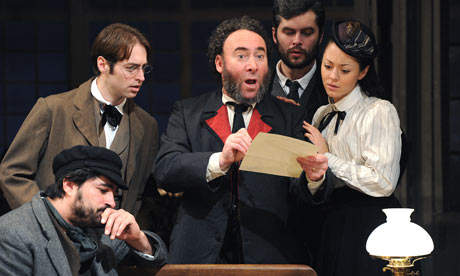
After its 15.3 million pound revamp, Sheffield’s Crucible theatre reopens with another actor-director at the helm, following in the illustrious footsteps of Michael Grandage and Sam West. Daniel Evans, the new AD, boasts an impressive CV but this is a step up and he makes it admirably, aided by the award winning theatrical superstar that is Antony Sher.
The play chosen to inaugurate this new regime is Henrik Ibsen’s Enemy of the People with Sher playing the Ibsen-esque protagonist Dr Thomas Stockmann even down to the Norwegian’s distinctive sideburns. Ibsen is enjoying something of a revival with Ghosts being staged at the Duchess in London. Enemy of the People, in a fine version by Christopher Hampton, as indeed with Frank McGuinness’ new Ghosts, does not steer away from the themes which landed Ibsen in such trouble in the 1880s and caused him to move from his native Norway to Italy and Germany, returning only twice – this flight something considered by Stockmann in the final scene.
Stockmann is a doctor and scientist in a small town in Norway. He and his brother Peter, the town’s mayor, are overseeing the completion of Thomas’ grand design, the opening of health spa which will boost the town’s economy. However, trouble looms when Stockmann discovers that the water supply contains harmful bacteria. Aided by the local press and the Property Owners’ Association, Stockmann believes he has his ‘solid majority’ by which to take on Peter and reveal that the baths pose a serious health risk. Getting wind of this, Peter picks off Stockmann’s allies by revealing the huge civic cost of the rectifying of the problem, this convinces Aslaksen, Chairman of the Property Owners’ Association, whilst the slimy, petty journalist Hovstad, played by the excellent Trystan Gravelle, his dissuaded from supporting Stockmann by being spurned by the Doctor’s daughter Petra. Stockmann, fuming from his loss of support, vows that truth will vanquish the lies of bureaucracy, a common theme in Ibsen’s early work, and opens Act II with a public meeting in which he performs the anti-Marc Antony and alienates his crowd by comparing them to dogs and declaring himself superior because of his devotion to truth. The crowd turns mob and declares Stockmann an ‘enemy of the people’; he is hounded through town and his house attacked. Stockmann’s world now falls apart, he loses his job, as does Petra, he is evicted, his sons sent home from school and, after his father-in-law buys up the cheap shares in the baths with his wife’s inheritance, their value slashed by fears of Stockmann publicising his report about the bacteria, as an incentive for him to save the reputation of the spa and himself, Aslaksen and Hovstad pay the doctor a visit accusing him of being a conman and using the whole affair as a money making opportunity. Stockmann closes the play surrounded by his family and his one remaining ally, Captain Horster, declaring that “the strongest man in the world is the man who stands most alone” whilst perched above the open attic hatch; an ending as ambiguous as any in this genre of late Victorian modernism.
Enemy of the People was an accomplished show with a beautifully designed set and the Crucible, after its refit, has lost none of its immediacy and closeness that the venue became famous and loved for. Evans directs well and Sher, who was disappointing in the first act, comes into his own in the second with his bombastic and rousing antithesis of good political oration. As mentioned above the performance of the local newspaper editor Hovstad was excellent from Trystan Gravelle, his scene with Phillip Joseph’s Aslaksen trying to hide the Stockmann brothers from each other at the print shop was performed with great energy and comic timing. John Shrapnel and Lucy Cohu as the controlling, overbearing town mayor and Stockmann’s long suffering wife respectively also gave a fine turns. Hovstad’s sub-editor Billing however grated and his wild enthusing became more of an annoyance than crucial to the vision. One of the great triumphs of the production however was the use of a community ensemble as those gathered at the meeting and it reminded the audience of the community spirit the old Crucible used to exude.
This play, a moral tale of one man’s struggle to reveal an ugly truth, is telling in the era of the Chilcot Inquiry and senior officials being threatened with criminal proceedings. A fine start for Evans at Sheffield and a reminder of the power of the Norwegian master that is Henrik Ibsen.
Enemy of the People: ****
Image courtesy of Tristam Kenton.
No comments:
Post a Comment